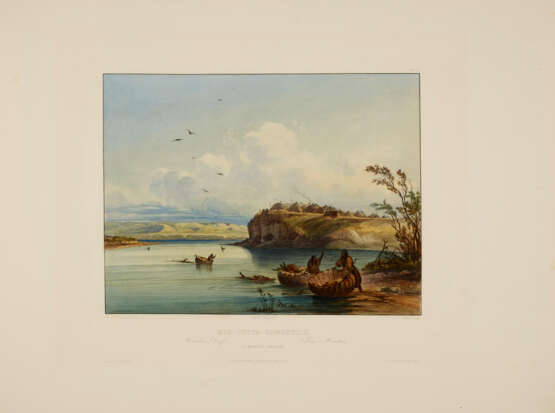ID 965139
Los 20 | Reise in das innere Nord-America in den Jahren 1832 bis 1834
Schätzwert
$ 500 000 – 800 000
Prince Maximilian and Karl Bodmer, 1839-1841
MAXIMILIAN, Alexander Philipp (1782-1867) and BODMER. Karl (1809-1893). Reise in das innere Nord-America in den Jahren 1832 bis 1834. Coblenz: J. Holscher. Paris: Bertrand], 1839-1841.
“A faithful and vivid picture” (from the preface, translated). The first copy of the fully hand-colored issue of Bodmer’s masterpiece to be offered at auction in about 30 years.
Extremely rare, fully hand-colored first edition of the most important illustrated book on the American West; the plates all in early states, and text on large-paper. An original German front wrapper is preserved. This work recounts the travels of the German Prince Maximilian of Wied on the upper Missouri River in 1832-34, accompanied by the Swiss artist Karl Bodmer. As distinct from previous explorers, Prince Maximilian went without a political or financial agenda, but simply to see what he could see. He and his entourage went "as far upstream as the American Fur Company post of Fort Mackenzie in present-day Montana, and spending the winter at Fort Clark, near the Mandan Indian villages. During this prolonged stay, he and Bodmer had ample opportunity to observe the Indian tribes of the Upper Missouri...
Bodmer's atlas, made up of smaller vignettes and larger tableaus of scenes from the trip, is justly famous for its extraordinary depictions of the Indians of the Upper Missouri. These are, in fact, the best images of American Indians executed before the era of photography ... No other images of American Indians even come close to these in accuracy, detail, and execution, faithfully transferred from the original [watercolors] to the aquatint plates under Bodmer's close supervision of the printing of the atlas" (Best of the West).
This work was offered by its publishers in uncolored, partially colored, or fully colored editions with the text printed on large Imperial paper, as here. The fully colored edition was of course the most expensive and the most desirable, as it is today, almost 200 years later. Of this German, fully colored edition, there were just 46 subscribers listed in volume 2. Brandon Ruud suggests that the total number assembled was likely between 100 and 200. The last copy of the fully-colored issue that we trace at auction was the Richard Manney copy, sold in 1991.
The plates themselves underwent considerable revision during printing and are known in from two to five or more states. Typically the first state would have the simplest caption; images were occasional re-worked and captions were updated to include the English translation, the numbering changed from roman to Arabic, printers’ were credited or uncredited, etc. The last state was almost always the only one to be dated within the plate. Of the 81 plates in the present set, 74 are in the first state, five are in the second state and three are in the third state—and none of the plates are dated. The first of the vignettes, depicting the Boston Lighthouse, is the only image first printed with a caption only in English, as here. It is one of just 100 printed in this first state. The vignette plates, too, are all on the smaller size paper as original intended by the publishers, confirming an early issue.
The preserved wrapper in the tableaux atlas is a rarity in itself; there are only two known complete sets of wrappers—at the Beinecke and at the Joslyn Art Museum. The large type on dark blue paper, “promises a fantastic voyage to the viewer” (Ruud). This wrapper once contained eight plates, and it is specified that they were for “Augabe No. V,” i.e. with all 81 plates hand-colored and the text on Imperial paper. Best of the West 73; Field 1036; Howes M443a (“dd”= superlatively rare); Sabin 47014; Wagner-Camp 76:1. See Ruud, ed., Karl Bodmer’s North American Prints, 2004.
Two large-paper “Imperial” quarto text volumes (357 x 264mm); one broadside folio atlas of tableaux, oblong (447 x 603mm); and one folio atlas of vignettes, oblong (291 x 420mm); together, four volumes. Text: Wood-engraved illustrations (erasure on vol. 1 title-page, intermittent foxing, vol. 2 first gathering and last quarter of text toned). Tableaux atlas: 48 hand-colored aquatint and engraved plates, several printed a la poupée in shades of blue, sepia, and gray, all with artist's blindstamp (scattered few foxmarks, mostly to margins and versos, light foxing to pls. 14, 22, and 47, a little spotting in sky of pl.27, pale varnish stain on pl.30, pale toning/light stains from old guards on pls. 37, 40, pls. 14 and 44 about 1cm shorter than other plates). Lithographed key and weather table and large engraved hand-colored route map bound in at end. Upper wrapper for part 17-18 bound in to the front of tableaux volume. Vignette atlas: 33 aquatint and engraved plates all with artist's blindstamp (a little fingersoiling, a couple of surface nicks to pl.16). Text volumes and tableaux atlas in uniform 19th-century half calf over marbled boards, spines gilt in compartment; vignette atlas in 19th-century half calf, upper cover lettered in gilt “Vignetten zu Prinz zu Wied / Reise in Nord-America;” housed in four modern half morocco clamshell boxes.Bodmer, Karl
Maximilian, Prince zu Wied-Neuwied
Montana
Western Americana
| Herkunftsort: | Westeuropa, Deutschland, Europa |
|---|
| Herkunftsort: | Westeuropa, Deutschland, Europa |
|---|
| Adresse der Versteigerung |
CHRISTIE'S 20 Rockefeller Plaza 10020 New York Vereinigten Staaten | ||||||||||||||
|---|---|---|---|---|---|---|---|---|---|---|---|---|---|---|---|
| Vorschau |
| ||||||||||||||
| Telefon | +1 212 636 2000 | ||||||||||||||
| Fax | +1 212 636 4930 | ||||||||||||||
| Nutzungsbedingungen | Nutzungsbedingungen | ||||||||||||||
| Versand |
Postdienst Kurierdienst Selbstabholung | ||||||||||||||
| Zahlungsarten |
Banküberweisung | ||||||||||||||
| Geschäftszeiten | Geschäftszeiten
|
















